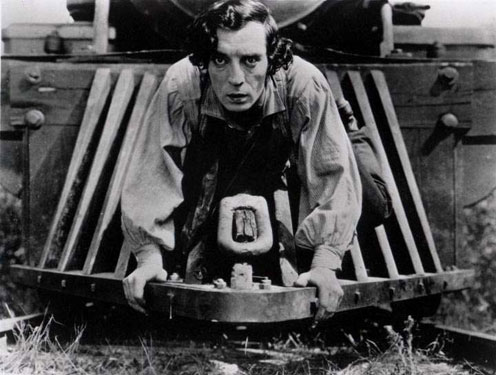
Posted on 12/28/2010 10:43:43 PM PST by smokingfrog
(Excerpt) Read more at wral.com ...

Cool!
wow
One of the best movie crash scenes ever!
I can’t believe that wreck was real. I guess I am CGI’ed to the point in thinking everything Hollywood did the past 20 years is fake.
Talk about needing to get a shoot right the first time!
How the heck do you "redo" something like that?
Looked great on the big screen of a movie theater.
My thought, too. Loses a lot on the small screen. Dittos for ID4. (ID4 destructions, BTW, were done with scale models, not computer graphics.)

Fine. Go get a cane pole, catch the fish that ate him.
I thought Hollywood types cared about the environment???? Why did they leave this massive pile of litter in the pristine wilderness??????
When Buster Keaton made his movie, The General (1926) and finished filming the scene of the locomotive crashing off a bridge into the waters below, he left the wreckage behind. It remained there until WWII when it was collected for scrap metal for the war effort.
Ditto. I always figure with computers these scenes are CGI'ed. It's impressive to hear about a special effects shot done using the real thing.
I'm reminded of a scene in the movie 'Gladiator' where Maximus (Russell Crowe) is in the arena with another gladiator and two chained tigers are released from hidden pits (a sort of extreme 'out of bounds' marker). First time I saw the movie I thought wow those tigers look so real. It turns out they were real tigers!
From a WSJ review:
Ragtime Orchestra performing the film's light, uplifting, comical score.
The 1927 slapstick comedy stars Keaton as Johnny Gray, a hapless railroad engineer who does everything wrong - and in the process gets everything right.
At first rejected by the Confederate Army, he manages to rescue The General, the stolen locomotive he's the engineer for, then defeats the Union Army in battle, earns his officer's stripes, and gets the girl.
Keaton was at the height of his fame when he made the movie, which is brimming with examples of his comic timing, physical daring, and frantic energy.
Keaton manages to express as much feeling with his face as his body. With his long nose, high cheekbones and big eyes, he conveys joy, surprise, fear, irritation, whatever emotion a scene demands.
Dressed in vintage garb like the rest of his musicians, conductor and pianist Rick Benjamin led the Paragon in a spirited performance. There were a few easily recognizable songs, like "Dixie" and "I've Been Working on the Railroad." But much of the music was simply a direct expression of the action on the screen.
In addition to an extended chase scene with one slow-moving locomotive trying to catch up with another, Keaton is faced with a variety of obstacles - lightning, a bear, a rainstorm and a broken sword. And the Paragon was right there, setting the mood. Sometimes the vintage drum set stood out, sometimes the beat was set by the violins, while at other times, the cornet seemed to mock Johnny Gray's earnestness.
The combination of film and music elicited a lot of laughter from the audience, even when a train fell into a river as it traversed a burning bridge, even as Keaton unwittingly killed a Union sniper with his broken sword.

I just figured this was WIlly Green’s back yard.
Try 41 years. The era of CGI began with the moon landings in 1969.
Ha!!

Disclaimer: Opinions posted on Free Republic are those of the individual posters and do not necessarily represent the opinion of Free Republic or its management. All materials posted herein are protected by copyright law and the exemption for fair use of copyrighted works.